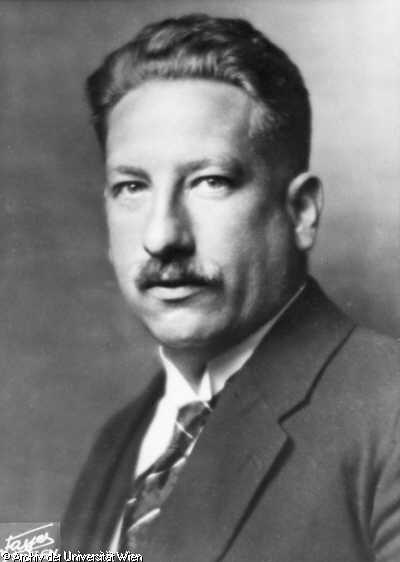Friedrich Kottler
| Born: |
12-10-1886 |
| Faculty: |
Philosophical School |
| Category: |
Expelled teacher |
Friedrich KOTTLER (born on December 10th, 1886 in Vienna, died on May 11th, 1965 in Rochester/New York) was extraordinary professor ("ao. Prof.") for physics (mathematical physics) at the Philosophical School of the University of Vienna.
He was persecuted in times of Nazism as a Jew lost his position and was thrown out of the university in 1938.
Kottler, the son of a court advocate, attended secondary school in Vienna until 1905
[1] and then served as a volunteer for one year in the imperial-royal fortress artillery regiment Kaiser no. 1 in Vienna and Franzensfeste.
[2] He began studying physics at the University of Vienna in 1906 and obtained his doctorate “sub auspiciis imperatoris” (an especially distinguished form of graduation) in 1912
[3] with the dissertation “Ueber die Raumzeitlinien der Minkowskischen Welt”.
[4] In it, Kottler was for the first time able to introduce absolute differential calculus into the special theory of relativity. Three years later, Albert Einstein used this mathematical tool to develop his general theory of relativity.
[5]
Kottler, who was made lieutenant of the reserve in 1911,
[6] entered the First World War in 1914 and took part in the battles of Namur, Maubeuge, Antwerp and Ypres with a motorized unit. From 1916 until 1917 he commanded a howitzer unit in the Bucovina, Rumania and East Galicia as well as at the 12th battle of Isonzo. Among other things he received the Iron Cross Second Class
[7] and had risen to the rank of senior lieutenant of the reserve until the end of the war.
[8] Still during the war, in 1916,
[9] Kottler, who after obtaining his doctorate as a theoretical physicist applied himself to the theory of relativity, was able to habilitate for the special and general theory of relativity at the University of Vienna.
[10] In 1921 he received the title of associate professor,
[11] which was followed by an expansion of his teaching license to mathematical physics and their analytical aids in 1922.
[12] Already one year later he became associate professor for mathematical physics.
[13]
Kottler taught at the university until Austria’s “Anschluss” to the German Reich. On a list from the office of the dean of the philosophical faculty from April 9th, 1938, he is named among persons that were “to be suspended for political and ideological reasons, to ensure peace and order at the faculty”.
[14] One of the reasons could have been Kottler’s work on the theory of relativity, which was rejected by the National Socialists since it was considered to be “Jewish”. In a protocol, drawn up with Kottler at the rectorate on March 21st, 1938, it is noted that Kottler was “of Jewish descent on his mother’s side”.
[15] It is also possible that both of these were reasons for the measure against him. In any case, the suspension was realized by a decree of the ministry of education on April 22
nd, 1938,
[16] and Kottler was sent into retirement on May 28
th.
[17]
Subsequently, Kottler decided to leave Austria and the “Third Reich” and emigrated to the United States in the summer of 1939.
[18] He found a job as a chemist at the Eastman Kodak Company in Rochester, New York and Minneapolis, Minnesota and did important contributions to the theory of particle size distribution when working at Kodak. However, Kottler, who became an American citizen in January 1945,
[19] did not work at any universities there, according to the available information.
[20] Ten years after the end of the war, he wanted to apply for his retirement at the Eastman Kodak Company and return to Austria for the first time in more than one and a half decades to hold a one- or two-hour course at the university.
[21] The ministry approved the request put in by the faculty on December 31st, 1955, making Kottler an honorary professor for mathematical physics.
[22] The last document in the personnel files is dated from February 6th, 1956. In this Kottler made known that he would not be able to move back to Austria before April 1956 and could then start his lectures in the winter semester of 1956/57 at the earliest.
[23]
Among his most important works are “Über Einsteins Äquivalenzhypothese und die Gravitation” (1916), “Maxwell’sche Gleichungen und Metrik” (1922) and the article “Imagery of One-Dimensional Patterns” in the Journal of the Optical Society of America (Vol. 56, 1966).
[24]
Before the “Anschluss” he had been a member of the Viennese Chemical-Physical Society and the German Physical Society.
[25]
Lit.: Archive of the University of Vienna/PHIL PA 2286, PHIL GZ 659 ex 1937/38, RA GZ 680 ex 1937/38; MÜHLBERGER 1993, 43; ANGETTER/MARTISCHNIGG 2005; EMÖDI/TEICHL 1937; PLANER 1929.
[2] UA, PA, fol. 11, Curriculum vitae, 22. 6. 1914.
[5] UA, PA, fol. 52, Kommissionsbericht, o. D. (1922).
[6] Ebd., fol. 11, Curriculum vitae, 22. 6. 1914.
[12] UA, PA, fol. 40, BM f. I. u. U. an PHIL Dekanat, 21. 7. 1922.
[14] UA, PA, fol. 157, PHIL Dekanat an Österreichisches Unterrichtsministerium, 9. 4. 1938 (Abschrift).
[15] Ebd., RA GZ 680-1937/38, O.-Nr. 52, Protokoll, aufgenommen in der Rektoratskanzlei, 21. 3. 1938.
[16] Ebd., fol. 47, PHIL Dekanat an Kottler, 23. 4. 1938.
[17] Ebd., fol. 4, BMU an Kottler, 26. 10. 1960; vgl. UA, PHIL GZ 659-1937/38, O.-Nr. 147, Österreichisches Unterrichtsministerium an PHIL Dekanat, 28. 5. 1938.
[18] UA, PA, fol. 58, Kommissionsbericht, 7. 12. 1955.
[19] Ebd., fol. 4, BMU an Kottler, 26. 10. 1960.
[21] UA, PA, fol. 58, Kommissionsbericht, 7. 12. 1955.
[22] Ebd., fol. 67, BMU an PHIL Dekanat, 31. 12. 1955.
[23] Ebd., fol. 64, Kottler an PHIL Dekanat, 6. 2. 1956.
Andreas Huber (translated by Thomas Rennert)
